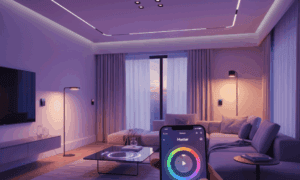The evolution of wall clock design deeply impacts interior decor choices. Over centuries, styles adapted from traditional to modern minimalist forms that complement open-concept spaces. Digital clocks now display time through large screens without hands.
Whether analog or digital wall clocks remain a versatile accessory that informs while decorating. For those updating a room, incorporating trending designs offers affordable style refreshments. Modern and digital clocks are installed seamlessly in small areas where voluminous furniture won’t fit.
Interior designers and resellers know popular current options. Clean-lined minimalist modern clocks coordinate Scandinavian and mid-century modern aesthetics. Larger digital displays draw the eye above mantles and in kitchens.
A Brief History of Wall Clock Design
Traditional wall clocks have evolved significantly from early religious-themed designs. Modern styles now provide clean, minimalist aesthetics that incorporate on-trend digital features as well. Those looking to freshen a home’s decor on a budget can find appealing digital and modern wall clock options from a variety of manufacturers and retailers specializing in these products.
Sellers offer simplified designs with large easy-to-read screens, often including additional functions beyond timekeeping. Popular modern clocks feature slimline silhouettes and solid colors that blend seamlessly into various interior styles. Both analog and digital versions offer versatile accessories that elevate a space through functionality and visual appeal.
In the 18th century, clock designs became more stylized as fine furniture pieces and status symbols. The 19th century saw the rise of mass production, making basic mechanical wall clocks accessible to middle-class homes. Innovation continued with the introduction of battery power in the 20th century and quartz movements in the 1970s that improved accuracy.
Modern Wall Clock Styles
Modern wall clocks are represented by sleek, minimalist designs that complete a variety of interior aesthetics. Clean-lined silhouettes feature simple shapes and sparse ornamentation in contrast to more elaborate historical pieces. Styles may have educational, children’s, Chinese wooden, large black or glass materials in natural tones that blend seamlessly into any room.
Top-selling modern clock styles include:
- Chinese Wooden Wall Clock
- Minimalist wall clock in the shape of a wood stump 30 cm
- 3D Wooden Stump Wall Clock 30cm
- Children’s cloud-shaped wall clock 31×38 cm
- Children’s Wall Clock with a Bunny 31×22 cm
- Wall Clock with Colorful Flower Pink
- Educational Wall Clock with Animals for Children 30 cm
- Children’s wall clock with spring flowers 30 cm
- Large wall clock 70-90-100 cm
- Large black wall clock 100 cm
- Retro loft wall clock in black 34-40 cm
- pendulum wall clock 15×30 cm
- Cuckoo wall clock with pendulum 25x20x15 cm
Quality brands stand the test as prominently featured inventory, profitable both for sellers and homeowners regularly updating living spaces with on-trend wall accessories.
How does a modern wall clock work?
A modern wall clock functions similarly to traditional analog timepieces but with a cleaner aesthetic. Rather than an ornate face and spinning hands, it features a minimal circular or square frame to showcase the time. Inside works a basic mechanical quartz movement where a tiny battery-powered oscillator regulates precise ticks that drive simple punctual hands. Through this straightforward design, modern wall clocks tell time with a pared-back approach for understated yet graceful time telling.
The Digital Revolution in Clocks
Digital clock demand grows as technology transforms time display. Sellers profit by offering easy-to-read screen varieties utilizing affordable quartz chips and circuit boards over mechanical insides. LED and LCD screens replace hands with numerals, appealing to a minimalist aesthetic. Compact electronic innovators prove popular inventory additions wherever decor seeks functional wall accents refreshed by resident designers.
If you are looking to update your home’s decor on a budget, you must buy digital clocks as they offer modernized time telling through seamlessly integrated electronic screens without the cost of premium analog clocks. This innovation enabled entirely new features like multiple alarms, chronographs and calendar functions.
Style Compatibility
Wall clocks reflect interior aesthetics, so style complementarity matters. Modern pendulum-free designs coexist with minimalism through subtraction. Digital integration seamlessly upgrades contemporary living. You must buy digital clocks for their versatility complementing any décor through accentuating technology within visual appeal. Retailers boost profitable stocks catering looks adaptable through phases of trend.
How Digital Clocks Work?
At the heart of every digital clock is a quartz crystal, an integrated circuit, and a digital display. The quartz crystal generates precise oscillations when electrified, functioning as the clock’s timing element. An integrated circuit then utilizes the crystal’s signal to increment digital logic gates and derive a 1-second pulse. This processed information is sent to the clock’s display – typically an LCD or LED screen – which presents the visible time readout. Batteries provide power for both the quartz crystal oscillator and digital components as well as illuminating the display.
Features of Digital Wall Clocks
- Large, easy-to-read digital display (often 6-12 inches)
- Brightness control options for optimized viewing
- Accurate quartz movement for exact timekeeping
- Date and day display
- Alarm options include snooze and multiple alarms
- Stopwatch and/or countdown timer functions
- Calendar display showing dates
- Backlight for low-light visibility
- Silent or low-volume operation
- Battery-powered (AA or AAA) or AC adapter options
Choosing Between Modern vs Digital
- Size of space –Modern best for smaller rooms, digital good for large areas
- Noise sensitivity –Modern runs silently, digital may have audible ticking/alarms
- Aesthetic preferences – Modern blends in a subtly, digital bolder statement piece
- Hourly chimes –Digital can chime on the hour, modern usually quiet
- Ease of reading – Digital big clear numbers, modern lower profile design
- Nighttime visibility –Digital backlit, modern passive with no glow
- Battery life – Modern months/years, digital requires frequent replacements
Care and Maintenance
Proper care keeps wall clocks in good working order. Modern styles simply require light dusting of frames. Digital screens could use occasional wiping with a soft cloth. Quartz movements typically run for years but batteries may need periodic replacement. Resetting time after power loss takes only a button press. Minor servicing is rarely needed, though manufacturers provide support. With minimal upkeep, wall clocks can remain accurately ticking away for many years.
Material and Durability
Quality production matters when investing in wall accessories intended for years of daily use. Both analog and digital varieties offer durable builds worthwhile for resale longevity. Retailers ensure reliable inventory by sourcing proven brands constructing clocks from premium materials like machined metal and shock-resistant glass. You must buy digital clocks as their seamless electronic designs made to withstand everyday wear far surpass affordability. Sellers profit from digital options guaranteed to maintain precise timekeeping through the movement of décor.
Conclusion
Wall clocks evolved tremendously from mechanical beginnings. Integrating circuits enabled quartz precision and digital screens, categories still dominating markets where retailers thrive selling profitable innovators. Minimalist aesthetics complement precision in modern options. This guide provides digital advantages for budget-friendly decor upgrades – you must buy digital clocks for their seamless, sleek designs to meet demand. Though tech innovates constantly, classics like streamlined moderns maintain longevity, staples wherever interiors welcome functional, fashionable time display.




































